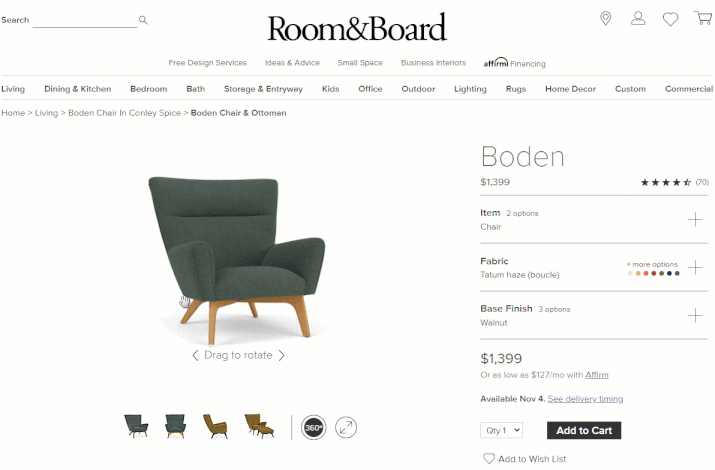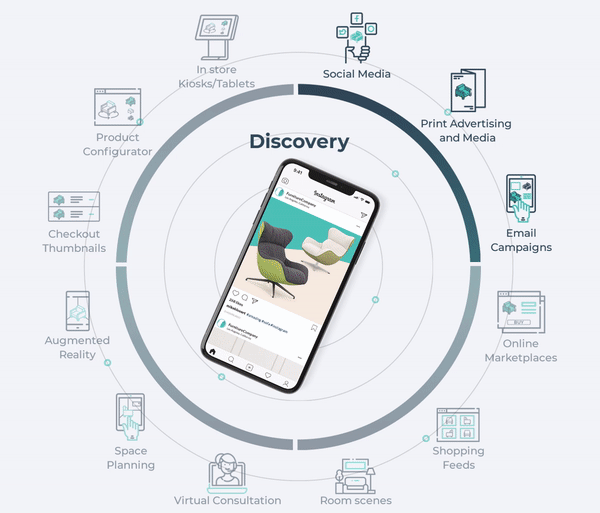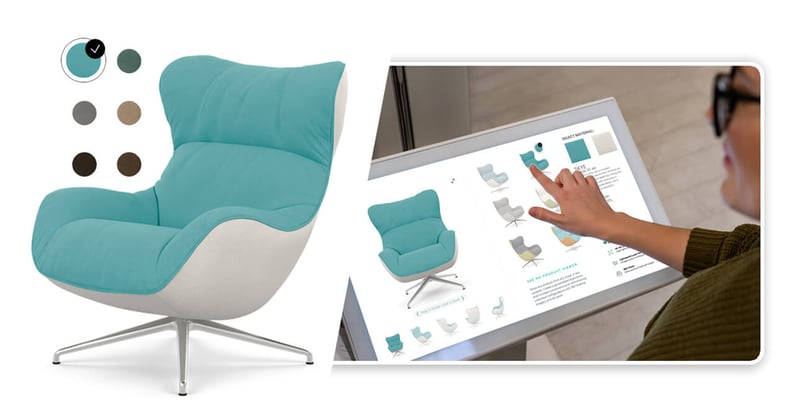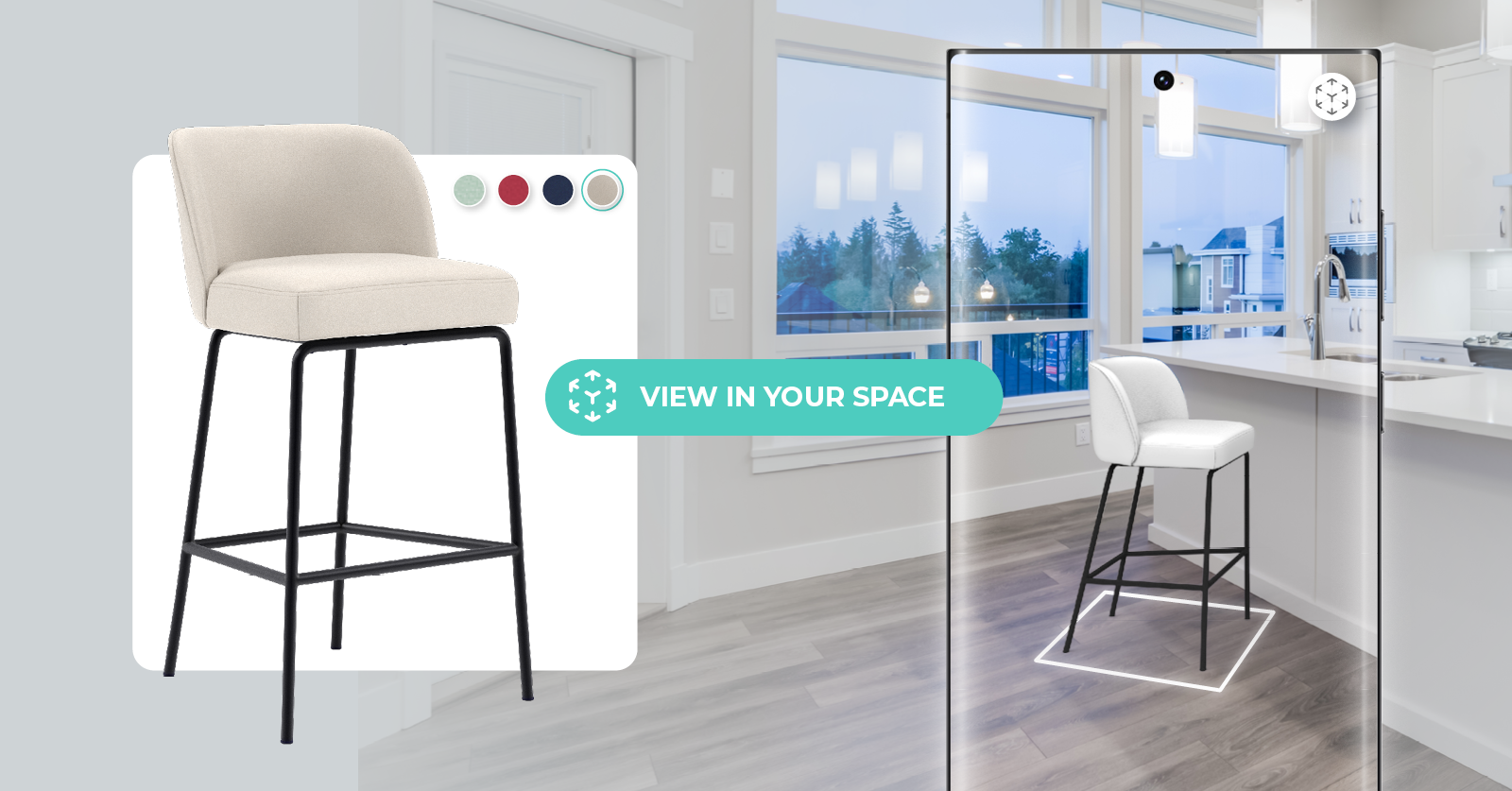It’s an exciting time to be in furniture retail. In the furniture e-commerce space, both demand and customers’ expectations of online shopping experiences are going up at the same time, leaving many furniture players with a “good news, bad news” dilemma.
Retailers who reinvent the furniture buyer journey and introduce a seamless online-offline experience will ultimately get a bigger piece of the pie. Unfortunately, the ones that fail in this process will stay empty-handed.
According to Statista, the global furniture e-commerce industry is forecast to reach about 41 billion U.S. dollars by 2030. Moreover, furniture e-commerce is one of the fastest-growing categories. Data from Comscore’s 2023 State of Digital Commerce Report shows that furniture and appliances represented the no. 5 top-grossing digital commerce category in 2022, contributing $76 billion to the $1.09 trillion total.
In other words: e-commerce will become a vital pillar for every furniture business that wants to succeed in the long run.
Now the tricky part. The only way to convince customers to click the “add to cart” button and buy a piece of furniture online is to introduce an engaging online shopping experience. And in the digital realm, product visualization is at the forefront of your website experience.
Moving forward, furniture businesses will find themselves at a crossroad: maintain the status quo or reinvent online furniture shopping with high-quality 3D product visualization services.
The cost of status quo
At a time when the world is moving at the speed of light, keeping things the way they are, means that you’ll soon be outdated.
Adopting new technologies means leaving your comfort zone, which can feel daunting. However, the cost of inaction exponentially increases as time goes on. So if it seems like a minor challenge now, soon it will become a big headache and a roadblock on your path to growth.
The cost of the status quo consists of all expenses associated with not deploying an essential technology that matches the complexity of your business.
One of the biggest challenges for the DTC furniture brand Loaf was how to visualize 100,000+ products in the quality and time frame they require. As soon as they noticed the red flags, Loaf’s team knew they needed to find a scalable solution.
“We were aware that every single day we delayed selecting a future-proof 3D product visualization vendor was another day, another resource wasted.” - Louis Adamou, Technology Director, Loaf
What is the best way to measure the cost of the status quo? Calculate all the expenses that you have to pay as a result of the inefficiencies in the process: organizing product photoshoots, manufacturing, transportation costs for the physical sample of the furniture item, low-quality 3D product visualization you can’t repurpose for multiple use cases, errors as a result of manual data entry, managing, storing, and repurposing assets ... and the list goes on.
When you add the wasted time required from your team for manual, repetitive work instead of working on value-added tasks, it is clear that the cost of status quo is much higher than the investment required, especially for furniture businesses that are in it for the long haul.
When e-commerce was still a greenfield, there was a saying: “If customers can’t see it, they can’t buy it.” Today, that’s not enough. Suppose you want to sell big-ticket items such as furniture. In that case, you have to display your product in the highest quality and introduce advanced features that will allow customers to inspect the product closely and replicate in-person shopping.
The writing is on the wall — not doing anything to prepare for the new era of furniture e-commerce is the most expensive decision you’ll ever make.
This begs the question: How can furniture businesses reinvent the online buyer journey with 3D product visualization and boost sales?
What is 3D product visualization?
3D product visualization is the process of creating a digital representation of a physical product using 3D software. The result is a digital twin of the product that lets customers visualize how a certain product looks without seeing it in person.
This technology has become mainstream in the last few years, making it one of the most effective methods for producing high-quality digital content.
The process of 3D product visualization starts by modeling the product in 3D, setting up environments with virtual cameras and lights, and then rendering a frame to get the desired results. Even though the process has similarities to traditional photography, the level of control and flexibility with 3D visualization is unmatched.
As a result of technology advancements, renderings are often more color-correct than photography. Moreover, 3D renderings can do things that photography can’t — 360-degree spin, product configurator, and interactive lifestyle images.

“The ability to rotate products on our website increases customer engagement and allows customers to see products from all angles, reducing questions about views customers couldn’t previously see, including product backs, seams, and wire management.” - Stephanie Kennedy, National Retail Market Manager, Room & Board
With all these advantages tipping the balance in favor of 3D product visualization, let’s get into the nuts and bolts of choosing the right vendor.
How to choose the right 3D product visualization vendor
Even though adopting new technology requires careful planning, choosing a 3D product visualization vendor doesn’t have to be scary. If you are looking for a framework to help you find the best solution for your business, you can use the one Loaf has in place every time they select a new technology partner.
“Whenever we're selecting new partners, especially in the technology space, we've got five questions we always ask ourselves:
- Does the vendor understand the problems Loaf is trying to solve for its customers?
- Does the vendor understand the problems Loaf is trying to solve for business stakeholders?
- Does the vendor complement Loaf's mission?
- Does the vendor represent the future of their industry?
- Are they a good cultural fit?
In order for Loaf to select anyone as a vendor, we have to feel comfortable that the answer is a solid yes to every single one of these questions. And if there's a gap, the likelihood is that we'll not work with that vendor.” - Louis Adamou, Technology Director, Loaf
With constantly evolving expectations and purchasing habits, you need a trusted 3D product visualization partner who can help you set the foundation of a futureproof visualization strategy. Let’s go into the ten most important aspects that will help you find the best 3D product visualization solution for your furniture business.
1. High quality
Details such as colors, fabrics, and textures are extremely important in furniture shopping. High-quality 3D product visualization is the closest you can get in the lifelike presentation of your products in the digital world.
To better understand the difference in quality that 3D product visualization vendors offer, you must understand the difference between high and low polygon assets.
A low poly asset is a 3D polygon mesh with a small number of polygons, so it often appears blocky and lacks detail. Even though a low poly asset depicts the basic shape of the product, it looks rudimentary, has rough edges, and can't demonstrate details.
On the flip side, high poly assets have an enormous amount of polygons, creating superior finishes and a photorealistic look.

While low poly assets are used for games and real-time 3D such as augmented and virtual reality and space planning, high poly assets are pre-rendered, and they are used for photorealistic product imagery and lifestyle shots.
The bottom line is that you can convert high poly models to low poly, but not the other way around. If you want to build your business on a solid foundation, make sure to create a future-proof content library of high poly assets that you can leverage across channels and use cases. Focus on 3D product visualization technology first, and then experiment with digital realities (augmented and virtual reality) later.
“The quality of the images was the most important aspect when choosing a 3D product visualization vendor. It was also important to find a partner who was collaborative and focused on building a long-term relationship to continue to enhance and strengthen the experience over time.” - Stephanie Kennedy, National Retail Market Manager, Room & Board
2. Scalability
When choosing a 3D product visualization solution, you have to think long term. If you’re planning to increase the number of products visualized in 3D and, over time, create 3D models of your whole product portfolio, then you need to find a partner that offers a scalable solution.
“When selecting a 3D product visualization vendor, we wanted a partner who would fully understand Loaf’s problems and who would accurately reflect and represent the products but also would be able to scale up with us, regardless of the number of models we have.” - Louis Adamou, Technology Director, Loaf
Furniture businesses are specific because the number of product variations with different colors, textures, patterns, and other details is often overwhelming. The only way to use 3D product visualization as fuel for your business, rather than being a stumbling block, is to find a vendor capable of supporting your future growth.
Even if you’re dipping your toes in 3D visualization for the first time and testing how it will work with a smaller batch of products, choosing a vendor that doesn’t have the capacity to answer your needs when the time comes means that you’ll have to go through the same process all over again.
To sum things up: when choosing a vendor, make sure that the models and the system you are building can be replicated on a much larger scale.
3. Product page load speed
One of the most overlooked aspects of the success of your e-commerce store is the product page loading speed.
Today’s customers expect instant gratification, so product pages that take too long to load will eventually hurt your bottom line.
But the negative impact of slow product page loading goes way beyond user experience. In fact, not paying attention to your page load speed can affect your SEO ranking, business reputation, and credibility.
Page load speed is especially critical if it is a user’s first encounter with your business. Imagine when a customer comes across your website during a research phase. If they bounce off your website because it loads too slowly, they likely won’t be back.
The first five seconds of page-load time have the highest impact on conversion rates, according to Portent. Nearly 70% of consumers admit that page speed impacts their willingness to buy from an online retailer.
On the other hand, customers expect a rich product page experience that will ease their decision-making process. Now the question on every marketer’s mind: Page load speed or rich product page?
The good news is that you can use high-quality product images and rich media without compromising speed or quality. Features like zoom, 360 spin, or in-context images can help you show more and sell more. You just need to pay attention to this aspect when choosing your 3D product visualization vendor.
4. Turnaround time
If you don’t take turnaround time into account when looking for a 3D visualization solution, you might end up postponing the launch of your new collection because your website is not ready yet. Sounds bad, right?
Being able to put things in motion as soon as you sign the contract with a new vendor is crucial. The longer you have to wait, the more your business suffers.
Time efficiency is one of the vital aspects you should look for when deciding on any partnership you want to join. The reason is simple: A slow turnaround time can completely derail your business.
As the furniture industry is becoming more dynamic, moving fast will become a prerequisite for success.
Recently, the outdoor furniture disruptor, Outer, introduced the drop culture to the furniture space. The “drop” strategy means launching limited-edition product releases to generate hype by using scarcity. Hosting this type of event means that your website should be equipped with top-notch visuals and be ready to roll at all times.
5. All-in-one solution
Juggling with different tools can be a horror show. The worst part is, you won’t be able to leverage the maximum potential of each tool because you’ll be stuck trying to hold everything together.
If you’re in the process of selecting a 3D product visualization vendor, make sure to look for a solution that you can use across the buyer journey.
In the discovery phase, you need high-quality product visuals and GIFs for social media, email marketing, and print advertising. Crisp visuals can catch customers’ attention while they’re scrolling on social media or browsing the internet.
During the research phase, customers check online marketplaces, go through shopping feeds, and compare different options. If you don’t want to bet on the price, the only way to stand out from the crowd at this point is to showcase superior products. To do that, you need 3D product visualization.
When customers are in the consideration stage, they’re looking at different tools, such as augmented reality and space planners, to help them make the right decision. Offering virtual consultations complemented with 3D product visualization can bring customers closer to the “add to cart” button.
Finally, in the final stage of the buyer’s journey, customers go online or in-store. In both cases, product visualization can lead to higher conversion rates. By equipping its product pages with high-quality 360-degree views, the longtime industry leader in premium custom furniture, Mitchell Gold + Bob Williams, witnessed a lift in e-commerce upholstery sales by 60%.
By choosing the right solution, you can elevate your digital experiences with photorealistic product visuals for any touchpoint of the furniture buyer journey: product configurator, augmented reality, e-commerce merchandising, marketing campaigns, and much more.

6. Straightforward review process
The process of reviewing and approving models might look like the distant future when you haven’t even selected a vendor yet. However, being aware that this step can potentially lead to a lot of wasted time if there’s no streamlined process in place makes it one of the essential selection criteria.
Imagine huge spreadsheets and countless emails, going back and forth on the details that need to be fixed before you approve the final look of the product. Not the best scenario, right?
Looking for a vendor with an efficient product approval process in place can save you time and boost your productivity, letting you focus on strategic tasks. But what does a streamlined review process look like? It means having a tool where you can go through the list of products that have been visualized and leave feedback about the things that should be fixed. The end goal is to reduce the time spent in the review process and the number of iterations.
When choosing a vendor, look for a solution with a user-friendly interface and useful features that will simplify the review process. That way, you’ll avoid cumbersome processes and bouncing between emails and spreadsheets.
7. Strong partnership
When a vendor treats you as a partner, it means they are looking for ways to make the relationship mutually beneficial for both of you. How can you spot the difference?
It means that the vendor is trying to get to know the business challenges you are facing to better understand the results you want to achieve. Having a holistic view of all things related to your business, rather than just completing the required tasks, is the first sign of a good partnership.
Next is communication. Open communication is at the heart of every good business relationship. It all starts long before signing the contract. Look for a vendor that is honest about all the pros and cons of the solution and whether it’s a good fit for your business.
One of the first red flags in a relationship is when the sales team is no longer available after signing the contract. Even though you’ll be connected with other people from the company, the fact that you can’t reach out to your first point of contact can be frustrating.
To avoid this problem, always ask for referrals before signing the contract. That’s the best way to get a first-hand impression of what it is like to work with that vendor.
8. In-store tool
Why use 3D product visualization for your e-commerce store only when you can leverage the 3D assets to boost in-store sales as well?
An endless aisle is a retail concept of using kiosks and tablets in-store that allow customers to browse and order products that are not showcased in-store. This way, you maximize the potential of your 3D assets.
According to Forrester Research, retailers who put endless aisle strategies to work noticed that this strategy accounts for up to 10% of their revenue.
The new chapter of furniture retail has replaced the old formula of measuring sales per square foot. The furniture store of the future will be all about experiential retail, and it will require measuring success by experience per square foot.
Limited physical store footprint doesn’t necessarily mean a bad customer experience. Thanks to technological advancements, retailers can replicate the engaging online experience in their stores by placing kiosks or tablets that allow customers to play with different colors and fabrics, even if the item is out of stock.
9. Focus on furniture
If you were going to hire someone to paint a mural on the side of your building, would you look for a general artist or someone who specializes in painting large-scale murals? The same goes for a 3D product visualization vendor. Look for a specialist.
"Jack of all trades, master of none" is not good enough for furniture product visualization. The complexity and the price tag of these big-ticket products require state-of-the-art product visualization that instills purchase confidence.
On top of the quality you can expect from a specialized furniture visualization vendor, you can also benefit from the industry knowledge and the network effect.
10. Futureproof solution
3D product visualization is so much more than just implementing new software. If you do it right, it can be one of the key pillars of your furniture business. Deciding who to partner with can make or break your business.
The pandemic has taught us that being able to pivot is the most important strength a business can have. However, you can’t move forward if the vendors you work with cannot respond to the new market expectations.
As the new era of furniture e-commerce unfolds, you have to focus on working with a vendor that has a clear roadmap for future platform development.
The 3D product visualization solution you choose can be your biggest strength or your greatest weakness. It’s up to you to make the right decision.
What’s next?
The right 3D product visualization vendor can be an extension of your business. From unparalleled quality, lightspeed load time, and an all-in-one tool to clearer project review cycles, faster turnaround time, and a true partnership — the 3D product visualization solution can be the essential gear in your well-oiled furniture e-commerce machine.
The question is: How to find a 3D platform that checks all the boxes?
We’ve compiled helpful guidelines for understanding your product visualization needs and a ten-point checklist specifically tailored to help furniture businesses choose the right 3D product visualization platform.






